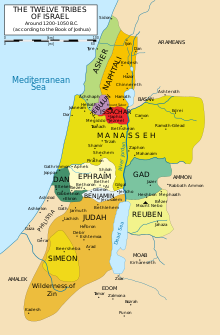Tribe of Judah

The territory of Judah appears in orange at the south on this map of the tribes. The text is partially in German.
|
|
| Geographical range | West Asia |
|---|---|
| Period | Confederated Tribes of Israel |
| Dates | ? – c. 1050 BCE |
| Major sites | Hebron, Bethlehem |
| Preceded by | New Kingdom of Egypt |
| Followed by | Kingdom of Israel (united monarchy) |
According to the Hebrew Bible, the Tribe of Judah (Hebrew: שבט יְהוּדָה, Modern Shevet Yehuda, Tiberian Shevaṭ Yəhûḏā; "Praise") was one of the twelve Tribes of Israel.
The Tribe of Judah (Yehudah), its conquests, and the centrality of its capital in Jerusalem for the worship of the god Yahweh figure prominently in the Deuteronomistic history, encompassing the books of Deuteronomy through II Kings, which most scholars agree was reduced to written form, although subject to exilic and post-exilic alterations and emendations, during the reign of the Judahist reformer Josiah from 641–609 BCE.
According to the account in the Book of Joshua, following a partial conquest of Canaan by the Israelite tribes (the Jebusites still held Jerusalem),Joshua allocated the land among the twelve tribes. Judah's divinely ordained portion is described in Joshua 15 as encompassing most of the southern portion of the Land of Israel, including the Negev, the Wilderness of Zin and Jerusalem. However, the consensus of modern scholars is that the conquest of Joshua as described in the Book of Joshua never occurred.
...
Wikipedia
